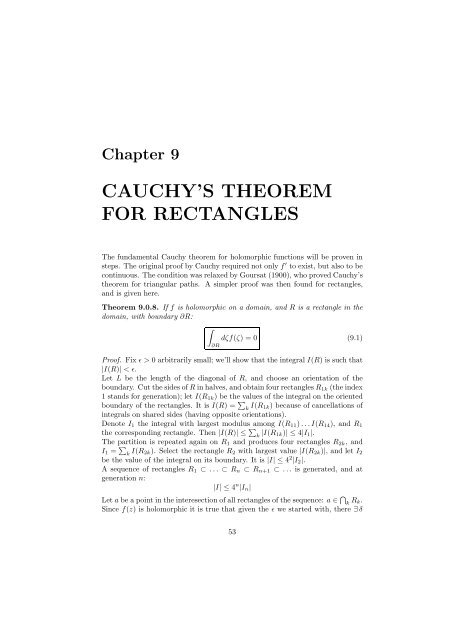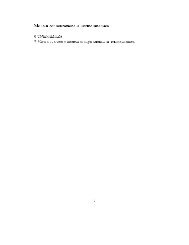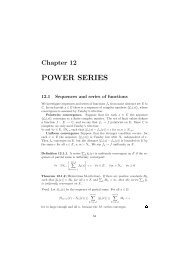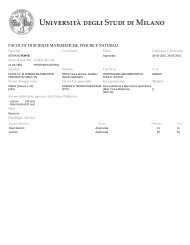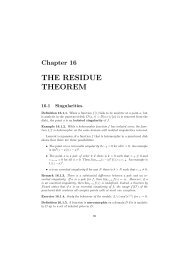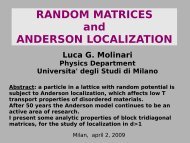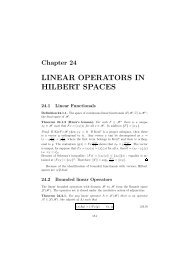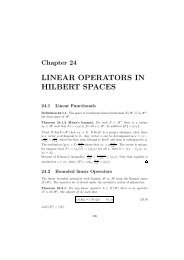CAUCHY'S THEOREM FOR RECTANGLES
CAUCHY'S THEOREM FOR RECTANGLES
CAUCHY'S THEOREM FOR RECTANGLES
Create successful ePaper yourself
Turn your PDF publications into a flip-book with our unique Google optimized e-Paper software.
Chapter 9<br />
CAUCHY’S <strong>THEOREM</strong><br />
<strong>FOR</strong> <strong>RECTANGLES</strong><br />
The fundamental Cauchy theorem for holomorphic functions will be proven in<br />
steps. The original proof by Cauchy required not only f ′ to exist, but also to be<br />
continuous. The condition was relaxed by Goursat (1900), who proved Cauchy’s<br />
theorem for triangular paths. A simpler proof was then found for rectangles,<br />
and is given here.<br />
Theorem 9.0.8. If f is holomorphic on a domain, and R is a rectangle in the<br />
domain, with boundary ∂R:<br />
∫<br />
∂R<br />
dζf(ζ) = 0 (9.1)<br />
Proof. Fix ǫ > 0 arbitrarily small; we’ll show that the integral I(R) is such that<br />
|I(R)| < ǫ.<br />
Let L be the length of the diagonal of R, and choose an orientation of the<br />
boundary. Cut the sides of R in halves, and obtain four rectangles R 1k (the index<br />
1 stands for generation); let I(R 1k ) be the values of the integral on the oriented<br />
boundary of the rectangles. It is I(R) = ∑ k I(R 1k) because of cancellations of<br />
integrals on shared sides (having opposite orientations).<br />
Denote I 1 the integral with largest modulus among I(R 11 )...I(R 14 ), and R 1<br />
the corresponding rectangle. Then |I(R)| ≤ ∑ k |I(R 1k)| ≤ 4|I 1 |.<br />
The partition is repeated again on R 1 and produces four rectangles R 2k , and<br />
I 1 = ∑ k I(R 2k). Select the rectangle R 2 with largest value |I(R 2k )|, and let I 2<br />
be the value of the integral on its boundary. It is |I| ≤ 4 2 |I 2 |.<br />
A sequence of rectangles R 1 ⊂ . . . ⊂ R n ⊂ R n+1 ⊂ . . . is generated, and at<br />
generation n:<br />
|I| ≤ 4 n |I n |<br />
Let a be a point in the interesection of all rectangles of the sequence: a ∈ ⋂ k R k.<br />
Since f(z) is holomorphic it is true that given the ǫ we started with, there ∃ δ<br />
53
1 2<br />
3 4<br />
Figure 9.1: The integral on a rectangular path can be obtained as the sum of<br />
four integrals on the dashed paths. The contributions from overlapping but<br />
oppositely oriented sides cancel.<br />
such that<br />
f(z) − f(a)<br />
z − a<br />
= f ′ (a) + r(z, a)<br />
with remainder |r(z, a)| < ǫ for all z such that |z − a| < δ. In R n two points<br />
have separation at most L/2 n , therefore a rephrasing is: there ∃n (generation)<br />
such that f(z) = f(a) + f ′ (a)(z − a) + r(z, a)(z − a) where |r(z, a)| < ǫ for all<br />
z ∈ R n . This gives the estimate:<br />
∫<br />
∣ ∣∣∣<br />
|I n | =<br />
∣ dz[f(a) + f ′ (a)(z − a) + r(z, a)(z − a)]<br />
∣ = dz r(z, a)(z − a)<br />
∣<br />
∂R n<br />
∫∂R n<br />
∫<br />
≤<br />
|dz||r(z, a)(z − a)| ≤ ǫ 4L<br />
∂R n<br />
2 n sup |z − a| < 4ǫ L2<br />
z∈∂R n<br />
4 n<br />
(Note that ∫ ∂R<br />
dz(cz + d) = 0 on any rectangle, by use of the primitive). Then<br />
|I| ≤ 4ǫ L 2 for arbitrary ǫ, so it equals zero.<br />
The hypothesis of the theorem can be weakened to allow for functions that<br />
are holomorphic up to a point in the domain (or a finite collection of points).<br />
This will be useful to study Cauchy-type integrals.<br />
Proposition 9.0.9. Let f(z) be a function that is continuous on a domain D<br />
and holomorphic on D/{a}. Then ∫ dζf(ζ) = 0 for any rectangle R in the<br />
∂R<br />
domain.<br />
Proof. If a /∈ R nothing changes in the proof of 9.0.8. If a ∈ R the key ingredients<br />
for a proof are: |f(z)| < M (because f is continuous on a compact<br />
set R) and Theorem 9.0.8. The trick is to decompose R = R a ∪ r 1 ∪ ... ∪ r k<br />
54
where R a is a square with side ǫ that contains a (as interior or boundary point<br />
if a ∈ ∂R), and r i are rectangles that fit the partition. The contour integral is<br />
I(R) = I(R a ) + ∑ i I(r i). Darboux’s inequality gives I(R a ) ≤ 4Mǫ, and the<br />
terms I(r i ) = 0, by Theorem 9.0.8. Then I(R) = 0.<br />
Example. [Fourier transform of the Gaussian function]<br />
An important application of the theorem for rectangles is the Fourier transform<br />
of the Gaussian function:<br />
∫ ∞<br />
−∞<br />
dx<br />
√ e −x2 +ikx = √ 1 e −k2 /4 , k ∈ R (9.2)<br />
2π 2<br />
Consider the integral ∫ ∂R dζe−ζ2 on the rectangle with corners ±R, ±R+i(k/2).<br />
The integral is zero because the function is entire, and is the sum of four integrals<br />
evaluated on the sides. For R → ∞ only integrals on [−R, R] and [−R +<br />
i(k/2), R + i(k/2)] survive and give the final result.<br />
55


